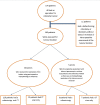The Accuracy of Different Modalities Used for Preoperative Primary Tumour Localisation in Operated Colorectal Cancer Patients
- PMID: 37009370
- PMCID: PMC10049957
- DOI: 10.7759/cureus.36737
The Accuracy of Different Modalities Used for Preoperative Primary Tumour Localisation in Operated Colorectal Cancer Patients
Abstract
Aim Colonoscopy and computed tomography (CT) scans of the abdomen and pelvis are routine pre-operative assessment tools in colorectal cancer (CRC) patients. There have been some discrepancies regarding the location of cancer when seen by colonoscopy versus CT scan. The purpose of this study was to compare the accuracy of a colonoscopy with a computed tomography (CT) scan of the abdomen and pelvis with contrast, which is done routinely before surgery to localise the exact site of the tumour within the large bowel, whilst comparing both to the operative, gross and histopathology findings of the exact location. Methods A retrospective study was carried out on 165 colorectal cancer patients operated on between January 1, 2010, and December 31, 2014, using electronic hospital records that were reviewed anonymously, comparing the location of cancer within the large bowels as was found on colonoscopy and CT scan of the abdomen and pelvis with contrast, comparing both to post-operative histopathology specimen or intra-operative assessment in cases where no resection of the primary tumour was performed. Results CT and colonoscopy were both accurate in diagnosing 70.5% of cases that had done both investigations pre-operatively. The best results were obtained when the cancer was located in the caecum as confirmed post-operatively; the combined accuracy rate was 100%. CT was accurate, whilst colonoscopy was not in eight (6.2%) cases (all are rectal or sigmoid cancers), and colonoscopy was accurate and CT was not in 12 cases, 10 of them were rectal and two were ascending colonic. Colonoscopy was not performed in 36 (21%) cases for a variety of reasons, including large bowel obstruction or perforation on presentation. In 32 of these cases, CT scan managed to accurately predict the location of cancer (mostly rectal and caecal), and CT scan was inaccurate in 20.6% of cases (34 out of 165), whilst colonoscopy was inaccurate in 13.9% of cases (18 out of 129). Conclusion Colonoscopy is more accurate in localising colorectal cancers than CT scan of the abdomen and pelvis with contrast. CT scan diagnoses regional and distant spread of colorectal cancers such as nodal status, invasion of neighbouring organs and/or peritoneum and the presence of liver metastases, whilst colonoscopy is limited to intraluminal diagnosis but can be both a diagnostic and therapeutic tool, with higher accuracy, in general, in localising colorectal cancers. Both CT scan and colonoscopy were equal in appendicular, caecal, splenic flexure and descending colon cancer localisation accuracy.
Keywords: colorectal cancer; colorectal neoplasia; ct accuracy; primary neoplasm location; colonoscopy; ct.
Copyright © 2023, Elnaggar et al.
Conflict of interest statement
The authors have declared that no competing interests exist.
Figures



References
-
- Global cancer statistics, 2012. Torre LA, Bray F, Siegel RL, Ferlay J, Lortet-Tieulent J, Jemal A. CA Cancer J Clin. 2015;65:87–108. - PubMed
-
- A comparison of colonoscopy and double-contrast barium enema for surveillance after polypectomy. National Polyp Study Work Group. Winawer SJ, Stewart ET, Zauber AG, et al. N Engl J Med. 2000;342:1766–1772. - PubMed
-
- Is there still a role for double-contrast barium enema examination? Canon CL. Clin Gastroenterol Hepatol. 2008;6:389–392. - PubMed
-
- Virtual endoscopy: is it reality? Vining DJ. Radiology. 1996;200:30–31. - PubMed
-
- A review of the technical and clinical aspects of virtual endoscopy. Kay CL, Evangelou HA. Endoscopy. 1996;28:768–775. - PubMed
LinkOut - more resources
Full Text Sources
